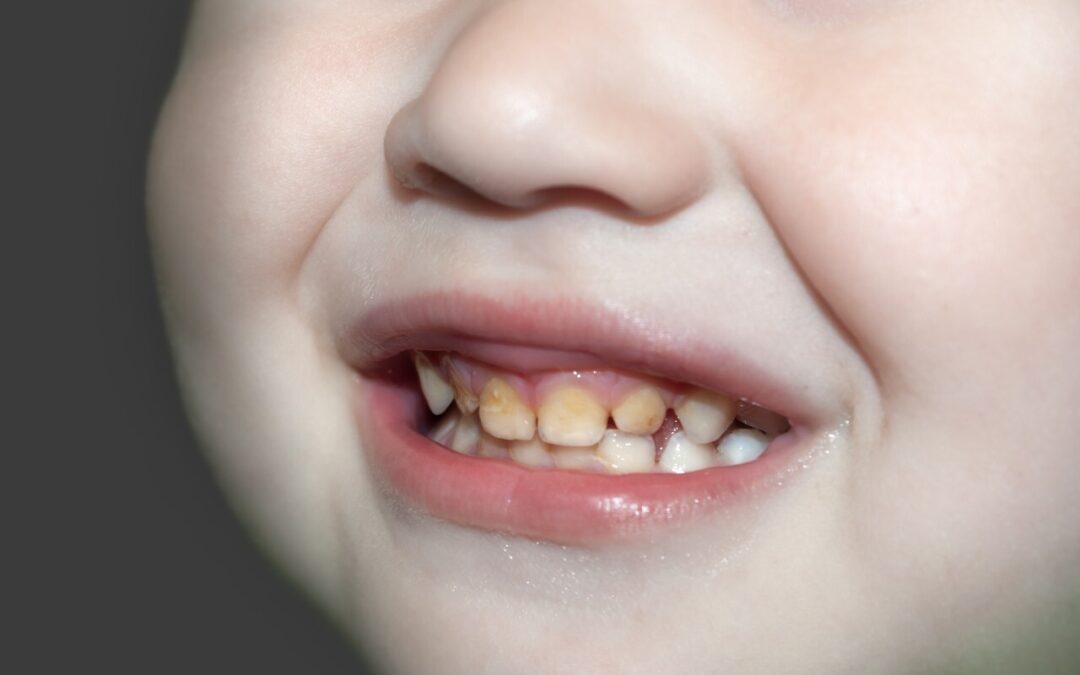How many of you have kids with a wide toothless gap in their smiles? It’s such a fun rite of passage for kids as they discover a loose tooth and wiggly wiggle it until it falls out. Taking bites can become a bit of a challenge again, particularly if they’ve lost more than one front tooth at a time. Apples, pizza, corn on the cob; all fun foods that they’ve mastered by this age and yet once again you’re likely having to cut things for them again.
Good news though, that once the teeth start falling out, that means the body is getting ready for the permanent teeth to erupt. So, what does it mean when your child’s adult teeth are coming in discolored or yellow?
They’re New – Why Aren’t They White?
The quick answer here is: biology. The fact is, permanent teeth simply aren’t the same color as the milk teeth. This is all about the wondrous complexity of our human bodies at work here, folks. The outer shell of the tooth, the enamel, directly covers what is called the dentin of the tooth. The color of dentin is a darker, somewhat yellowish color. When these brand new permanent teeth erupt, the enamel coating is somewhat transparent thereby allowing the darker color of the dentin to show through. Furthermore, permanent teeth have more dentin and nerve canals that are larger in comparison to their baby teeth.
The juxtaposition of pearly white baby teeth next to newly erupted permanent teeth may also enhance the yellowed appearance. As more milk teeth fall out, and more permanent teeth erupt, the uniformity of color in their smile will return. Additionally, over time the permanent teeth will calcify which will also lighten their color.
This is the number one reason for darker looking permanent teeth in kids for the overwhelming majority. There are however, a few other potential causes which we’ll review:
-
Exposure to certain antibiotics
-
Thin enamel
-
stains or buildup
-
Injury or trauma
Other Potential Causes for Yellow Permanent Teeth
Tetracycline Side Effect
Every time you see or hear an advertisement for a medicine there’s a spiel at the end warning of potential side effects. Well, you can add teeth discoloration as a potential side effect to some antibiotics, specifically tetracycline.
Tetracycline will actually bond to the teeth (yes, even teeth that have not yet erupted). When these tetracycline-bonded teeth erupt, the component will oxidize thereby discoloring the teeth a yellowish color that can further darken to brown.
The good news for you here, is that this side effect is widely recognized among doctors. It is uncommon for a doctor to prescribe a pregnant woman or young child these types of antibiotics for this very reason. If you are concerned, there is no harm in asking your doctor about the potential side effects of a prescribed antibiotic.
Thin or Weak Enamel
Enamel is the body builder, the body guard, the security team, the shield of the teeth. It is by its very nature, solid. In fact, enamel is stronger than bone, stronger than any other part of our bodies. As is the case with human genetics however, some of us inherit a trait for thinner (weaker) enamel. If your dentist has told you that your tooth enamel is a bit thin or weak, it’s possible you’ve passed that trait on to your child. Thinner enamel means the darker color of dentin will better show through.
Stains or Buildup
Yellow teeth can also be a result of poor dental hygiene. Poor dental hygiene means plaque and tartar buildup which is often yellow and sometimes even brown. Moreover, certain drinks and foods can stain teeth. Soda, coffee, dark tea, energy drinks, sports drinks, and even tomato sauces, soy sauces, raspberries and blueberries.
You don’t have to avoid those foods or drinks completely (although soda really is terrible for your kids’ teeth) however try to consume in moderation, or be sure to follow consumption with drinking water.
Injury or Trauma
A fall or a blow to the jaw doesn’t always mean a cracked or knocked out tooth. Sometimes the tooth can be damaged but remain. If the blood vessels within the tooth or the nerve break or are damaged it can cause tooth discoloration as well.
Dental injuries are unfortunately common, and we strongly urge that all kids utilize mouth guards for any sports. For more information about mouth guards, check out our in-depth post, “April Awareness for Facial Protection and Oral Cancer”.
How Do I Treat My Child’s Discolored Teeth?
If after reading this article, you remain concerned about your child’s teeth discoloration, give us a call to schedule an appointment. Tartar and plaque buildup need to be addressed by a thorough cleaning because they will lead to tooth decay. Furthermore, if you believe your child has thin or weak enamel because you know someone in your family has it, it’s important to let us know so that we can discuss risk, and a plan for preventative care.
As always, brushing for two minutes twice a day is the most important routine you can establish for your child’s dental health. Wearing a mouth guard for sports, even sports that aren’t considered contact sports, will help protect from dental trauma injuries. Whitening or bleaching products for children may be available in your local drugstore, but we are reluctant to encourage their use.
The truth is, your permanent teeth were likely yellow when they erupted as well, but look at your smile now! Keep up with the brushing routines and don’t forget to get your kids in for their biannual checkup and cleaning before the year runs out. We have appointment times available now and are always accepting new patients.


Recent Comments